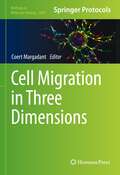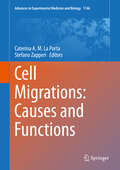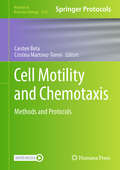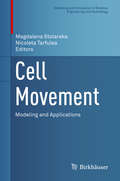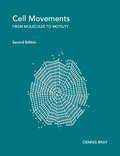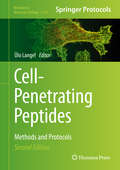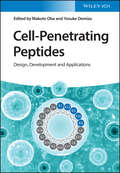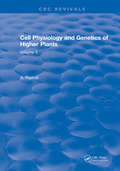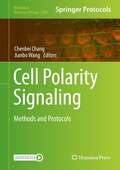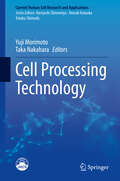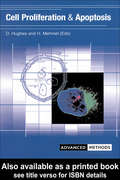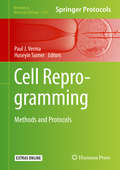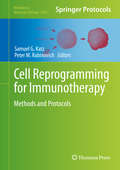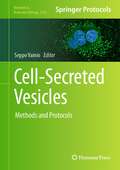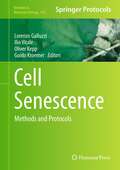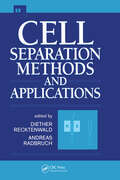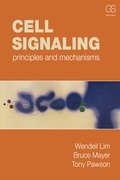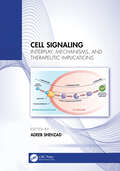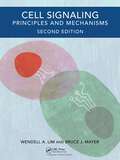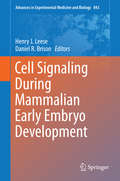- Table View
- List View
Cell Migration in Development, Health and Disease (Learning Materials in Biosciences)
by Anke Brüning-Richardson Sabine KnippThis textbook gives an insight into the importance of cell migration in health during development, wound healing and immune responses as well as in disease with particular focus on cancer. The reader will learn about the different ways cells migrate to allow cellular changes during development to occur, as well as responses to injury and threat by foreign invaders. Cell migration is a driver of invasion and ultimately metastasis in cancer and as such we will give examples from highly aggressive cancer such as brain tumours. The book also includes an introduction to mathematical modelling to predict cell migration, information on the development of software for analysis of data generated in 2D and 3D as well as recent developments in the investigations into cell migration using 3D bioprinting. This textbook will be a great learning tool for advanced undergraduate students and Master students with the relevant science degrees such as in cell biology, developmental biology, cancer research, and tumour biology.
Cell Migration in Three Dimensions (Methods in Molecular Biology #2608)
by Coert MargadantThis detailed collection serves as a unique and excellent collection of state-of-the-art methods and protocols to interrogate cell migration in a wide variety of different contexts and model organisms, as well as advanced image analysis and quantitative assessment of a diverse array of parameters related to cell migration. The book focuses on the cell biology of cell migration, developmental model systems to assess cell migration during morphogenesis, cell migration in cancers and the tumor micro-environment, as well as blood vessel formation and interactions. Written for the highly successful Methods in Molecular Biology series, chapters include introductions to their respective topics, lists of the necessary materials and reagents, step-by-step and readily reproducible laboratory protocols, and tips on troubleshooting and avoiding known pitfalls. Authoritative and practical, Cell Migration in Three Dimensions provides a solid foundation for scientists of different disciplines to investigate cell migration in biological processes. Chapters 7, 12, 16, 17, 19, 22, and 24 are available open access under a Creative Commons Attribution 4.0 International License via link.springer.com.
Cell Migrations: Causes and Functions (Advances in Experimental Medicine and Biology #1146)
by Caterina A. M. La Porta Stefano ZapperiCell migration plays an important role during development and in many physiological and pathological processes, from wound healing to cancer. This edited volume presents a collection of contributions meant to illustrate the state of the art on this topic from an interdisciplinary perspective.Readers will find a detailed discussion of the properties of individual and collective cell migration, including the associated biochemical regulation and important biophysical and biomechanical aspects. The book includes information on the latest experimental techniques employed to study cell migration, from microfluidics to traction force microscopy, as well as the latest theoretical and computational models used to interpret the experimental data. Finally, the role of cell migration in cancer and in development is also reviewed.The contents of this work should appeal to students and researchers in biology and biophysics who want to get up to date on the latest interdisciplinary development in this broad field of research. The chapters are written in a self-contained form and can also be used as individual articles.
Cell Motility and Chemotaxis: Methods and Protocols (Methods in Molecular Biology #2828)
by Carsten Beta Cristina Martinez-TorresThis volume explores the latest experimental and computer-based methods used to study the field of motility research. The chapters in this book cover topics such as methods to investigate motility and chemotaxis in a range of systems including macrophages and Dictyostelium discoideum; ways in which electric fields impact motility and taxis; recently developed computer-based methods for studying pseudopod-driven locomotion of amoeboid cells; and software tools for kymograph-based analysis of cell contour dynamics. Written in the highly successful Methods in Molecular Biology series format, chapters include introductions to their respective topics, lists of the necessary materials and reagents, step-by-step, readily reproducible laboratory protocols, and tips on troubleshooting and avoiding known pitfalls. Cutting-edge and practical, Cell Motility and Chemotaxis: Methods and Protocols is a valuable resource for researchers looking to expand their knowledge of motility-related research across different disciplines.
Cell Movement: Modeling and Applications (Modeling and Simulation in Science, Engineering and Technology)
by Magdalena Stolarska Nicoleta TarfuleaThis book contains a collection of original research articles and review articles that describe novel mathematical modeling techniques and the application of those techniques to models of cell motility in a variety of contexts. The aim is to highlight some of the recent mathematical work geared at understanding the coordination of intracellular processes involved in the movement of cells. This collection will benefit researchers interested in cell motility as well graduate students taking a topics course in this area.
Cell Movements: From Molecules to Motility
by Dennis BrayCell Movements vividly describes how complex movements can arise from the properties and behaviors of biological molecules. This second edition is updated throughout with recent advances in the field and has a completely revised and redrawn artwork program. The text is suitable for advanced undergraduates as well as for professionals wishing for an overview of this field.
Cell-Penetrating Peptides: Methods and Protocols (Methods in Molecular Biology #1324)
by Ülo LangelIn recent years, a new understanding of cell-penetrating peptides has emerged, helping researchers to expand beyond a number of long-held dogmas. In Cell-Penetrating Peptides: Methods and Protocols, expert researchers explore the latest information on cell-penetrating peptides (CPPs), providing insight into the most important and contemporary areas of CPP research. Chapters address the historical background of CPP studies, provide an overview of the growing field of research, investigate methods for testing CPP mechanisms, present a summary of methods that attempt to use properties of CPPs to study biochemical intracellular mechanisms of interaction and signal transduction, and include new ideas for turning CPP-based strategies into drugs. Composed in the highly successful Methods in Molecular BiologyTM series format, each chapter contains a brief introduction, step-by-step methods, a list of necessary materials, and a Notes section which shares tips on troubleshooting and avoiding known pitfalls. Innovative and current, Cell-Penetrating Peptides: Methods and Protocols is an essential guide that allows researchers to study intracellular mechanisms in new ways, and to promote the future development of novel drugs.
Cell Penetrating Peptides: Methods and Protocols (Methods in Molecular Biology #2383)
by Ülo LangelThis third edition summarizes the most important areas of Cell-Penetrating Peptides (CPP) research. Chapters are divided into three parts detailing the historical background of CPP, the classifications of the available CPPs, approaches for prediction of novel CPPs, methods for studies of “naked” CPPs, and a brief summary of functionality issues of CPPs, both in vitro and in vivo. Written in the format of the highly successful Methods in Molecular Biology series, each chapter includes an introduction to the topic, lists necessary materials and reagents, includes tips on troubleshooting and known pitfalls, and step-by-step, readily reproducible protocols. Authoritative and cutting-edge, Cell Penetrating Peptides: Methods and Protocols, Third Edition aims to be a useful practical guide to researches to help further their study in this field.
Cell-Penetrating Peptides: Design, Development and Applications
by Makoto Oba Yosuke DemizuCell-Penetrating Peptides The definitive reference on the rational design of cell-penetrating peptides enables readers to develop tailor-made peptides for their specific needs. In recent years, cell-penetrating peptides (CPPs) have become valuable tools for the cellular delivery of proteins, nucleic acids, and drugs. These small peptide sequences can be artificially designed and synthesized with custom-made characteristics to mediate the efficient and non-toxic transport of biomolecules, drugs, or nanoparticles into the cell. Cell-Penetrating Peptides: Design, Development, and Applications provides an up-to-date account of the development and use of CPPs for delivering membrane-impermeable bioactive molecules into cells. Bringing together contributions from leading researchers from around the world, this comprehensive volume describes the characteristics and mechanisms of CPPs as well as their application in both medicine, biotechnology and agriculture. Covers rational design and development of cell-penetrating peptides for use in cellular delivery of small molecule drugs, proteins, nucleic acids, and nanoparticles Presents the chemical and biological characteristics of CPP action in vitro and in vivo Describes the structure and design principles of both synthetic and naturally occurring CPPs Discusses key medical applications of CPPs such as oral delivery, intranasal delivery, and clinical trials Cell-Penetrating Peptides: Design, Development, and Applications is an essential resource for biochemists, medicinal chemists, molecular biologists, biotechnologists, and researchers studying CPPs in both academia and industry.
Cell Phone Safety
by Kathy Allen Frank W. BakerIf you get a text from a stranger, do you know what to do? Don't worry if you don't. This book is here to help! Learn tech-savvy ways to keep your cell phone a safe zone without taking away all the fun!
Cell Phones: Bringing the World Together [Grade 2]
by Chandler Tyrrell Lyle MillerNIMAC-sourced textbook
Cell Physiology and Genetics of Higher Plants: Volume II
by A. RashidThis book is devoted to fundamental aspects concerning cell physiology that are basic to the theme of biotechnology of higher plants. It highlights the regeneration potential of higher plant cells, for micropropagation of plants. The book is concerned with the genetic engineering of plants.
Cell Physiology and Genetics of Higher Plants: Volume I
by A. RashidFirst Published in 2018. Routledge is an imprint of Taylor & Francis, an Informa company.
Cell Polarity Signaling: Methods and Protocols (Methods in Molecular Biology #2438)
by Jianbo Wang Chenbei ChangThis volume explores detailed methods to investigate various aspects of biology related to cell polarity, or asymmetry within a cell. Molecular, cellular, and tissue-level regulation and function as well as diseases caused by impairment of cell polarity are explored by these methods. Beginning with advanced imaging and biochemical methods, the book continues with planar cell polarity (PCP) signaling in morphogenesis in diverse developmental contexts, apicobasal (AB) cell polarity in development and diseases, as well as directional cell migration and biomechanics in cell polarity. The collection includes the usage of a wide variety of model systems and an extensive array of techniques, including genetic, imaging, biochemical, and biomechanical. Written for the highly successful Methods in Molecular Biology format, chapters include introductions to their respective topics, lists of the necessary materials and reagents, step-by-step, readily reproducible laboratory protocols, and tips on troubleshooting and avoiding known pitfalls. Authoritative and comprehensive, Cell Polarity Signaling: Methods and Protocols aims to enable researchers to delve into the stimulating field of cell polarity and contribute to our understanding of how coordinated control of protein stability, trafficking, membrane retention, post-translational modification, and dynamic organization leads to active regulation of cell polarity. Chapter 29 is available open access under a Creative Commons Attribution 4.0 International License via link.springer.com.
Cell Processing Technology (Current Human Cell Research and Applications)
by Yuji Morimoto Taka NakaharaAnimal cells have been used in a wide range of applications, from pharmaceuticals to regenerative medicine and cell therapy, as well as evaluating drugs and compounds. These applications are supported by cell processing technology, which refers to the process technology and quality control technology for aseptically culturing cells such as skin, cartilage, and bone cells in vitro and producing the result of cells or tissues. Cell Processing Technology provides the state of the art of cell-processing engineering, including new issues of efficient and automated culture technology of cells in transplantation and non-invasive cell quality assessment technology. The book will be of value to students and inexperienced engineers who are involved in drug discovery and cell medicine.
Cell Proliferation and Apoptosis (Advanced Methods)
by D. Hughes H. MehmetCell Proliferation and Apoptosis provides a detailed practical guide to cell proliferation and apoptosis detection methods. A novel approach combining both these areas allows important comparisons to be made. Topics covered include all aspects of tissue handling from collection, storage, fixation and processing through to locating and quantifying cells in different stages of the cell cycle. This book is an essential and comprehensive practical guide to these important and expanding areas.
Cell Reprogramming: Methods and Protocols (Methods in Molecular Biology #1330)
by Paul J. Verma Huseyin SumerThis volume provides an understanding of the factors involved in nuclear reprogramming, which is essential for the success of reprogramming. The book is aimed at reprogramming differentiated cells and germ line transmission of pluripotent stem cells and features chapters that deal with reprogramming-related issues such as analysis of mitochondrial DNA in reprogrammed cells and the isolation of reprogramming intermediates; alternative methods for nuclear transfer; the production of germ-line chimeras from embryonic stem cells and induced pluripotent stem cells; and neonatal care and management of somatic cell nuclear transfer derived offspring. Written in the highly successful Methods in Molecular Biology series format, chapters include introductions to their respective topics, lists of the necessary materials and reagents, step-by-step, readily reproducible laboratory protocols and tips on troubleshooting and avoiding known pitfalls. Authoritative and cutting-edge, is the perfect guide for molecular biologists, stem cell biologists, clinicians, biotechnologists, students, veterinarians and animal care technicians involved with reprogramming, nuclear transfer and transgenesis.
Cell Reprogramming for Immunotherapy: Methods and Protocols (Methods in Molecular Biology #2097)
by Samuel G. Katz Peter M. RabinovichThis volume details key protocols for developing strategies in immunotherapy. Chapters guide the readers through protocols related to various DNA, RNA and protein methods to reprogram the immune system, immune cells, analyzing the effect of the reprogrammed cells, and key methods to consider and analyze patients enrolled in clinical trials with novel immunotherapy regimens. Written in the highly successful Methods in Molecular Biology series format, chapters include introductions to their respective topics, lists of the necessary materials and reagents, step-by-step, readily reproducible laboratory protocols, and tips on troubleshooting and avoiding known pitfalls. Authoritative and cutting-edge, Cell Reprogramming for Immunotherapy: Methods and Protocols aims to ensure successful results in the further study of this vital field.
Cell-Secreted Vesicles: Methods and Protocols (Methods in Molecular Biology #2668)
by Seppo VainioThis detailed volume presents hands-on technological protocols used to target an array of cell-secreted extracellular vesicles (EVs) in a variety of biological systems. Beginning with methods for EV purification and analysis, the book continues with sections on the study of EV functions as well as specific systems and models allowing for the study of EVs of different origin. Written for the highly successful Methods in Molecular Biology series, chapters include introductions to their respective topics, lists of the necessary materials and reagents, step-by-step and readily reproducible laboratory protocols, and tips on troubleshooting and avoiding known pitfalls. Authoritative and practical, Cell-Secreted Vesicles: Methods and Protocols serves as an ideal guide to conducting systematic assays in an effort to further our understanding of the mode of assembly, secretion, and targeting of EVs which will serve eventually as new therapeutic openings.
Cell Senescence: Methods and Protocols (Methods in Molecular Biology #965)
by Ilio Vitale Oliver Kepp Guido Kroemer Lorenzo GalluzziCell senescence is the process whereby cells permanently lose the possibility to proliferate without undergoing cell death, and occurs in a plethora of distinct model organisms. In Cell Senescence: Methods and Protocols, expert researchers in the field detail the methods that are now commonly used to study cell senescence, in model organisms encompassing bacteria, fungi, worms, flies, zebrafish, and mammalian cells. These techniques cover the study of all the morphological, biochemical and functional manifestations of senescence at the cellular level and include protocols for population analyses and high-throughput approaches in suitable model organisms. Written in the highly successful Methods in Molecular BiologyTM series format, chapters include introductions to their respective topics, lists of the necessary materials and reagents, step-by-step, readily reproducible laboratory protocols, and key tips on troubleshooting and avoiding known pitfalls.
Cell Separation Methods and Applications
by Diether Recktenwald Andreas Radbruch"Offers complete coverage and assessment of cell separation technologies for analytical and preparative isolations of biological cell populations-demonstrating how to select and devise optimal sorting strategies for applications in biochemistry, immunology, cell and molecular biology, and clinical research. "
Cell Signaling
by Wendell Lim Bruce Mayer Tony PawsonCell Signaling presents the principles and components that underlie all known signaling mechanisms. The book provides undergraduate and graduate biology students with the tools needed to make sense of the array of specific pathways used by the cell to communicate. It describes basic signaling mechanisms such as protein interactions, changes in enzyme activity, post-translational modifications, subcellular localization of signaling molecules, and small diffusible signaling mediators. The book also explores the components of signaling pathways and how they are wired into pathways and circuits that can process information.
Cell Signaling: Interplay, Mechanisms, and Therapeutic Implications
by Adeeb ShehzadThis book provides a comprehensive understanding of cell signaling, molecular interactions, and their implications for human health and diseases. It introduces fundamental principles underlying cell communication through signaling molecules and their diverse transmission and reception mechanisms, highlighting their role in intercellular communication through voltage- and ion-gated channels, immunological and neuron synapses, and rhinovirus–receptor interaction involved in pathogenesis and disease development. Toward the end, the book highlights the profound implications of altered cell signaling pathways in the inflammation and immune response followed by the progression of various disorders, including cancer, endocrine disorders, and neurological illnesses. It explores the diagnostic and therapeutic implications of cell signaling in targeted therapies, highlighting advanced techniques for detecting signaling molecules and innovative therapeutic approaches to inspire new developments in precision medicine. It serves as an important resource for academics, students, and professionals in the fields of cell biology and biomedical sciences.Key Features: Provides in-depth understanding of cell signaling, exploring its complexities and impact on human health and disease Introduces fundamental principles of cell communication, emphasizing the different signaling molecules and their various transmission pathways Focuses on complex structures and functions of receptors, highlighting their essential role in intercellular communication and regulating cellular behavior Examines the molecular aspects of cell surface adhesion receptors, elucidating protein–protein interactions, signaling cascades, and enzyme–substrate interactions Discusses the impact of cell signaling on inflammation, cancer, and endocrine and neurological disorders
Cell Signaling, 2nd edition: Principles and Mechanisms
by Wendell A. Lim Bruce J. MayerCell Signaling provides undergraduate and graduate students with the conceptual tools needed to make sense of the dizzying array of pathways that cells use to detect, process, and respond to signals from the environment. By emphasizing the common design principles and molecular processes that underlie all signaling mechanisms, the book develops a broad conceptual framework through which students can understand diverse signaling pathways and networks. The book first examines the common currencies of cellular information processing and the core components of the signaling machinery. It then shows how these individual components link together into networks and pathways to perform more sophisticated tasks. Many specific examples are provided throughout to illustrate common principles, and to provide a comprehensive overview of major signaling pathways.Thoroughly revised, this second edition includes two new chapters and substantial updates to the text and figures throughout the book.Key features: The book provides a conceptual framework through which all signaling pathways can be understood without memorization of details It is extensively illustrated, including high-quality diagrams and schematics to elucidate important concepts and processes Each chapter concludes with a useful summary section that brings together the key concepts End-of-chapter review questions test the reader’s understanding of the material covered Two new chapters have been written especially for this edition: "Signaling and Disease" and "Diversity in Signaling across Phylogeny"
Cell Signaling During Mammalian Early Embryo Development (Advances in Experimental Medicine and Biology #843)
by Henry J. Leese Daniel R. BrisonThe book considers signaling events from the zygote embryo through to the blastocyst with relevant data from embryonic stem (ES) cells, including dialogue with the extracellular environment and with the maternal tract during the implantation process. Application of the knowledge described to improve the success of human and animal assisted conception is considered where appropriate, but the focus is largely on fundamental rather than applied cell/molecular biology, as this is the area that has historically been neglected. While the general features of metabolism during preimplantation development are well established, especially in terms of nutrient requirements, uptake and fate, remarkably little is known about early embryo signaling events, intracellular or intercellular, between individual embryos in vitro or with the female reproductive tract in vivo. This contrasts with the wealth of information on cell signaling in somatic cells and tissues, as a glance at any textbook of biochemistry illustrates. This lack of information is such that our understanding of the molecular cell biology of early embryos -- a prerequisite to defining the mechanisms which regulate development at this critical stage of the life cycle -- is seriously incomplete. This volume is the first to address this issue by describing the current state of knowledge on cell signaling during mammalian early embryo development and highlighting priority areas for research.

